Renal Unit, Royal Cornwall Hospital
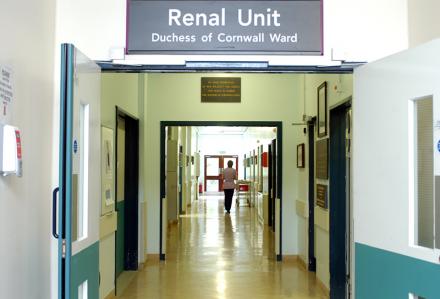
Using a classic resource efficiency method the team at the Renal Unit quickly identified carbon reduction opportunities, prioritised them, and moved into action. By the end of the first year they achieved:
- Clear improvements in the patient experience with nearly 50% less waiting, fewer aborted journeys and more self-care.
- An improved workplace for staff with more time to look after patients, and better attendance.
- A reduction in healthcare acquired infections
- ‘Cost avoidances’ running at £1,200 per employee per year
- Carbon reductions running at approximately 33 tonnes CO2 eq per year.
By the end of the second year it was found the first year measured improvements were maintained and further actions included:
- Aborted ambulance journeys now zero, making a saving of £1,500 per month or £18,000 a year, increasing 1st year cost avoidance by £3,210.
- Dressing packs slimmed by a ‘lean’ analysis saving £800 p.a.
- Cardboard for recycling was reduced by 65% when Fresenius 5L containers were switched to pallet delivery, instead of 4 to a box – avoiding the waste in the first place.
- Staff attendance was c92% and is now c96% due to a number of improvements including rostering, getting the skills mix right and matching to patient flow.
- Renal disposables wastage of 5 dialysis sets per week has been reduced to zero by not setting up machines in advance. This amounts to a saving of £13,000 p.a.
- By changing direct delivery of renal lines to ‘Blue Diamond’ supplies, topped up from NHS stores Bridgewater, costs of £5,900 are being avoided.
After two years total cost avoidance is running at £57,500 per year.
With 25 employees on the unit this equates to £2,300 per employee per year.
And 52.3 tonnes CO2 equivalent are being saved year on year.
Programme
Three two-hour workshops* introduced staff to climate change issues and the use of resource efficiency methods to reduce carbon. Led by Renal Unit Manager Simeon Edwards the team took the action plan developed in these sessions and integrated it into the normal management of their unit for continuous improvement.
* Facilitated by Eco-nomic Ltd at a cost of £1,500
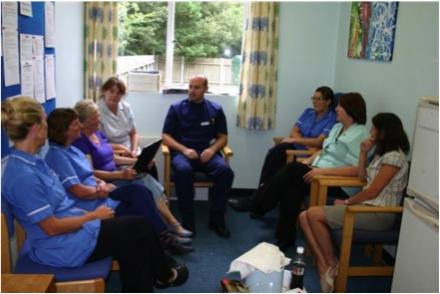
The carbon reduction actions are now regularly reviewed and updated as part of normal unit management. Resource efficiency tools are used as needed to get to the root of issues, identify possible actions, and to manage change positively.
Actions
Simple actions were attempted first:
Waste sandwiches were reduced from 35% to <5% by involving patients in establishing a new sandwich menu, improving choice and avoiding costs of £4,000.
After full consultation with patients, linen use was reduced by 70%. Some patients preferred to bring their own blankets, and the unit stopped using white sheets for patient’s chairs. Avoided costs £4,800 and quite a good carbon saving too.
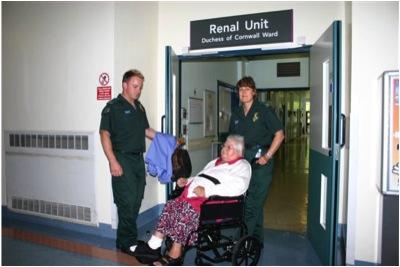
Encouraged by this success the unit team decided to tackle aborted ambulance bookings, aiming for zero %. The team worked with the ambulance service to synchronise treatment times. Within a few months the cost of aborted journeys reduced from £1,500 a month to £400, giving annual savings running at £13,200. After two years it is ‘zero’.
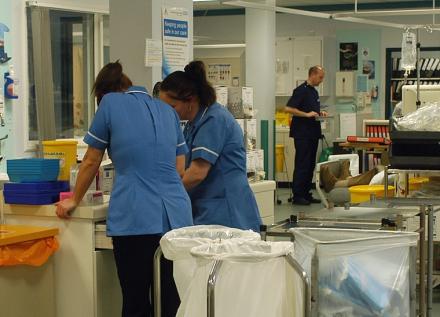
A much bigger challenge for the future is use of hospital cars (TAP). Staff transport awareness is also being encouraged, and measured, to improve active travel and reduce car use.
To reduce stress in the workplace the team undertook an analysis of the balance between staff availability and the peaks and troughs of patient activity.
This led to some rescheduling which released more time to care, leading on to best practice in infection control, and improved staff attendance.
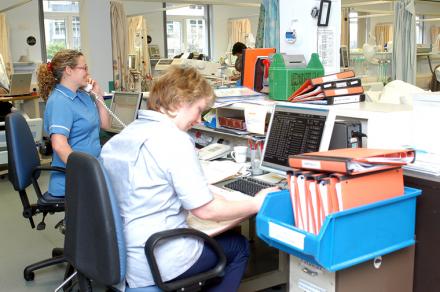
A renal unit uses a considerable amount of disposable kit and pharmaceuticals. Bicarbonate cartridges were changed leading to a reduction in both packaging and chemical. Cost avoidance now running at £11,000 p.a. Work is ongoing with manufacturers to reduce wastage of haemodialysis fluids. Other kit such as dialysis sets (20 tonnes of PVC waste p.a.) may be tackled in future. Great scope was found for eco-design in manufacture.
What's next?
Energy efficiency in heating is problematic. The unit has a summer average of 26C, too hot for staff comfort but chilly for patients undergoing dialysis. No ideal solution as yet, but the team continues to work on it.
A "switch off" campaign is underway. The team aim to reduce existing lighting by 25% by removing some lighting tubes. The equipment store awaits its light sensor.
Also still to come is the opportunity to reuse reverse osmosis waste water in toilets, as has been done at Canterbury, and other treatment improvement options.
Further recycling opportunities will also be explored. Indeed by year 2 recycled cardboard had been reduced by 65% by ‘not creating the waste in the first place’.
With renal cases increasing at 6% p.a. another big opportunity is the introduction of a self-care programme for renal patients. Benefits include the chance for patients to contribute to their own care at any level and gain control, less dependence on nursing staff, and the possibility of home treatment. All this will promote patient psychological welfare, but it has clear implications for sustainability too.
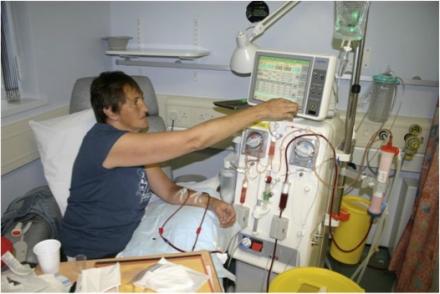
What does it feel like?
“It was very encouraging. We have taken on this project and are attending to our ‘green’ issues. It gives my job satisfaction.” Katherine Hope, Housekeeper.
Patient ‘A’: “I am always happy to get involved to contribute where possible because they do such a good job here.”
Barriers and money
“Finding money for initiatives is always difficult,” said Simeon Edwards, Unit Manager. “We now have cost avoidances running at over £57,000 a year as a result of this carbon reduction programme. It would be wonderful if we could re-invest some of that into more carbon reductions, for example to reuse the significant amount of reverse osmosis waste water the unit produces.”
Excellence and Quality
The initial funding for the programme was secured through The Cornwall Health Environment Committee, a county wide forum comprising the three NHS Trusts, Cornwall Council, and Unison along with NHSI contributions via the Campaign for Greener Healthcare. Mark Summers, Cornwall's Public Health low carbon lead, said, "This represents an excellent example of what can be achieved through collaborative working and how carbon reduction can be delivered through the pursuit of excellence and quality.
Calculating carbon
For a renal unit most of the carbon reductions clinical staff can tackle are embodied in ‘the things we do and use’ (scope 3), as the examples above illustrate. . Estates and Procurement were not involved in measuring this programme’s outcomes.
Today, in 2011, there is still no accepted and simple way to calculate scope 3 carbon savings. The following is new ground, an experiment to explore how such carbon savings can be calculated approximately so as to be more relevant and motivational to patients and staff.
While it is not possible to capture every benefit, for example staff time saved handling linen, it is often easy to identify cost avoidances. Consistent with the first year, these cost avoidances have been used in conjunction with “The 2009 Guidelines to Defra / DECC's GHG Conversion Factors for Company Reporting, Annex 13.
This enables a CO2 equivalent figure to be readily derived from cost figures to give staff an approximate idea of what they are achieving in carbon terms.
| Our action | Sic code | Category | Cost avoided p.a. | kg CO2eq |
| Sandwiches | 15 | Food & drink products | £4,000 | 6,371 |
|
Bicarb cartridges Dressing packs Dialysis sets Supply of renal lines |
24.4 | Pharmaceuticals |
£11,000 £8,000 £13,000 £5,928 |
24,911 |
| 70% linen reduction | 55 | Hotels, catering, pubs etc | £4,800 | 2,877 |
| Aborted ambulance journeys | 602 | Road transport | £18,000 | 14,790 |
| TOTAL | £57,528 | 54,327 |
For unit management purposes this is useful. It is now known at what rate annual carbon savings are running: and it offers a handy way to forecast which future actions will have most carbon value. As other actions and cost avoidances are added this total will grow year on year.
Knowing how much has been achieved in reducing a unit’s carbon impact on the world is motivational for staff and patients and will encourage further actions.
Download this case study as a pdf document:
